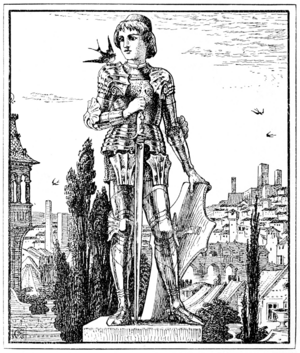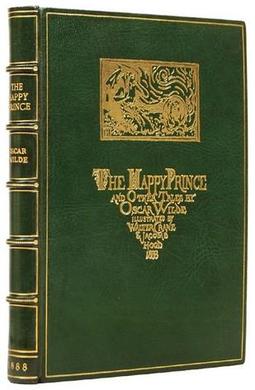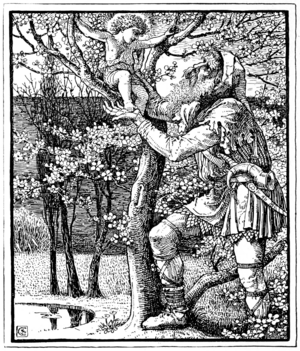The Happy Prince and Other Tales facts for kids
The Happy Prince and Other Tales is a collection of five wonderful stories for children written by Oscar Wilde. It was first published in May 1888. The book includes these famous tales: "The Happy Prince", "The Nightingale and the Rose", "The Selfish Giant", "The Devoted Friend", and "The Remarkable Rocket".
Contents
The Happy Prince: A Tale of Kindness

This story takes place in a city where many people are poor and suffering. A little swallow bird, who was left behind by his friends flying to Egypt for winter, meets a beautiful statue. This statue is called "The Happy Prince." The Prince had lived in a palace where no sadness was allowed, so he never knew what sorrow felt like.
From his tall spot, the Happy Prince can see all the suffering in the city. He asks the swallow to help him. He wants the swallow to take the ruby from his sword, the sapphires from his eyes, and the gold leaves covering his body. He asks the swallow to give these precious things to the poor people.
As winter gets colder, the Happy Prince loses all his beauty. He gives away everything he has. The swallow stays with him, helping him deliver the gifts. But the cold winter is too much for the little bird. The swallow dies from the cold and his kind deeds. When the swallow dies, the Prince's lead heart breaks into two pieces.
The people in the city don't know about the Prince's good deeds. They see the statue looks old and plain without its jewels and gold. So, they decide to take it down. They melt the metal in a furnace, but the broken lead heart and the dead swallow are left behind. These are thrown away onto a pile of trash.
However, an Angel from heaven sees these two things. The Angel believes they are the most precious things in the city. God agrees, and the Happy Prince's heart and the swallow live forever in God's "city of gold" and beautiful Paradise garden.
Stories of the Happy Prince: Adaptations
Many different versions of "The Happy Prince" have been made over the years.
- A radio play was broadcast in 1936.
- In 1941, Orson Welles and The Mercury Theatre made a radio version with music.
- Bing Crosby played the Prince in a 1944 radio show. He also recorded an album of the story in 1945.
- The British band Bee Gees released a song in 1968 called "When the Swallows Fly" that mentions the story.
- An animated movie was made in 1974, with Christopher Plummer as the Prince.
- The TV show Happily Ever After: Fairy Tales for Every Child set the story in New York City.
- In 2012, an Irish composer and playwright created a musical version for a narrator, choir, and orchestra.
- A musical based on the story was written in 1992.
- In 2014, a composer named Stephen DeCesare released his own children's musical version.
- In 2017, a theatre company adapted three of Oscar Wilde's tales, using "The Happy Prince" as a way to connect them.
- In 2019, a TV show called "Absolute Boyfriend" made many references to "The Happy Prince."
The Nightingale and the Rose: A Sacrifice for Love
This story is about a nightingale bird. She hears a student complaining because a professor's daughter won't dance with him. He needs a red rose to give her, but he can't find one. A lizard, a butterfly, and a daisy laugh at him.
The nightingale visits all the rose bushes in the garden. One rose tells her there is a way to make a red rose. But it requires a great sacrifice: the nightingale must sing her sweetest song all night long, pressing her heart against a thorn. This will cost her life.
The nightingale sees the student crying. She believes human love is more important than her own life. So, she decides to make the sacrifice. She sings beautifully all night, and a red rose grows, but she dies painfully.
The student takes the red rose to the professor's daughter. But she rejects him again! She says the Chamberlain's nephew sent her real jewels, and "everyone knows that jewels cost far more than flowers." The student gets angry and throws the rose into the gutter. He goes back to his studies and decides he will never believe in true love again.
Musical and Dance Adaptations
Many operas and ballets have been created based on "The Nightingale and the Rose."
- An American composer, Henry Hadley, wrote a cantata (a type of musical story) in 1911.
- An Australian composer, Hooper Brewster-Jones, created an opera in 1927.
- An English composer, Harold Fraser-Simson, made a ballet in 1927.
- An Italian composer, Renzo Rinaldo Bossi, wrote a one-act opera in 1938.
- A Latvian-Canadian composer, Jānis Kalniņš, created a ballet in 1938.
- A Russian composer, Elena Firsova, wrote a chamber opera in 1991.
- A South African composer, David Earl, made a one-act ballet in 1983.
- In 2015, a short film adaptation was screened at a festival.
The Selfish Giant owns a beautiful garden. It has 12 peach trees and lovely, sweet-smelling flowers. Children love to play in this garden after school.
The Giant returns home after visiting his friend, the Cornish Ogre, for seven years. He is angry to find the children playing in his garden. So, he builds a tall wall to keep them out. He puts up a sign that says, "TRESPASSERS WILL BE PROSECUTED" (meaning people who enter without permission will get in trouble).
Because the children can't play there, the garden falls into a never-ending winter. One day, the Giant wakes up to the song of a linnet bird. He discovers that spring has returned to his garden! The children found a small hole in the wall and sneaked back in.
The Giant realizes he made a mistake. He decides to tear down the wall. But when he comes out of his castle, all the children run away. All except for one small boy who was trying to climb a tree. The Giant gently helps this boy into the tree. He then announces, "It is your garden now, little children!" He knocks down the wall. The children come back and play, and Spring returns to the garden.
But the special boy the Giant helped does not return. The Giant is very sad. Many years pass, and the Giant happily plays with the children. He grows old and weak. One winter morning, he sees the trees in one part of his garden are full of blossoms. He goes outside and finds the boy he once helped standing under a beautiful white tree.
The Giant sees that the boy has marks on his hands and feet. He doesn't realize the boy is actually the Christ Child. The Giant is angry that someone has hurt him.
"Who has dared to hurt you?" cried the Giant. "Tell me, so I can take my big sword and fight him."
"No!" answered the child. "But these are the marks of Love."
"Who are you?" said the Giant. A strange feeling of wonder came over him, and he knelt before the little child.
And the child smiled at the Giant and said to him, "You let me play once in your garden. Today, you will come with me to my garden, which is Paradise."
Soon after, the happy Giant dies. That same afternoon, his body is found lying under the tree, covered in beautiful blossoms.
Different Ways the Story Has Been Told
"The Selfish Giant" has also been adapted into many forms:
- An English composer, Liza Lehmann, wrote a musical piece called The Selfish Giant in 1911.
- Another English composer, Eric Coates, wrote an orchestral piece in 1925.
- A Hungarian composer, Jenő Hubay, turned the story into an opera in 1933–1934.
- An animated movie of The Selfish Giant was made in Canada in 1971. It was even nominated for an Academy Award!
- In the 1990s, an Australian team created a children's ballet based on the story.
- The 1997 movie Wilde, about the author's life, included parts of "The Selfish Giant."
- In 2009, composer Stephen DeCesare adapted the story as a musical.
- In 2010, composer Dan Goeller wrote an orchestral version.
- A British drama film called The Selfish Giant was released in 2013, inspired by the story.
- In 2018, an English songwriter created a folk opera version.
The Devoted Friend: What True Friendship Means
This story starts with a water-rat talking to a duck. The water-rat then hears a linnet bird, who decides to tell a story to explain what true friendship really is.
The story is about a kind man named Hans. He had a beautiful garden where he grew many kinds of flowers to sell. Hans had a friend named Hugh, a miller. Hugh visited Hans often in the summer, and they talked about friendship. Hans was so devoted to Hugh that he even gave him bunches of flowers from his garden.
But when winter came, Hans had a very hard time. His flowers wouldn't grow, and he became very poor. He had to sell his gardening tools, like his wheelbarrow, to buy food. Meanwhile, the miller, Hugh, lived comfortably. He avoided visiting Hans or helping him, so he wouldn't make Hans jealous or ruin their friendship.
Finally, spring arrived, and Hans could sell his primroses again. Hugh finally visited him. When he heard Hans's problems, Hugh offered to give Hans his old, broken wheelbarrow. But in return, Hugh asked Hans for many favors. Hans, being kind and trusting, agreed. But the miller's endless requests kept Hans so busy that he couldn't even take care of his own garden.
One stormy, rainy night, Hugh asked Hans to go get a doctor for his son, who was hurt. Hans could barely see in the dark. After finding the doctor, Hans got lost on his way home and fell into a deep hole filled with water. He drowned.
Hugh pretended to be very sad at Hans's funeral. The linnet finished the story by quoting the miller: "'A great loss to me at any rate,' answered the Miller; 'why, I had as good as given him my wheelbarrow, and now I really don't know what to do with it. It is very much in my way at home, and it is in such bad repair that I could not get anything for it if I sold it. I will certainly take care not to give away anything again. One always suffers for being generous.'"
The water-rat, however, was not touched by the story. He said he wished he hadn't listened and went back into his home.
This story has also been adapted into comics.
The Remarkable Rocket: A Story of Pride
This story is about a firework. He is one of many fireworks ready to be set off at a prince and princess's wedding. This rocket is very proud and thinks he is extremely important. He looks down on all the other fireworks. He even starts crying to show how "sensitive" he is.
Because he cries, he gets wet and doesn't light up. The next day, he is thrown away into a ditch. He still believes he is meant for great things. He treats a frog, a dragonfly, and a duck he meets with great disrespect.
Two boys find him and use him to fuel their campfire. The rocket finally lights up and explodes! But no one sees him. The only thing he does is scare a goose when his falling stick lands near it.
"The Remarkable Rocket" is different from the other stories because it has many clever and witty sayings, which are called epigrams. Here is an example:
"Conversation, indeed!" said the Rocket. "You have talked the whole time yourself. That is not conversation."
"Somebody must listen," answered the Frog, "and I like to do all the talking myself. It saves time, and prevents arguments."
"But I like arguments," said the Rocket.
"I hope not," said the Frog calmly. "Arguments are extremely bad, for everybody in good society holds exactly the same opinions."
See also
 In Spanish: El príncipe feliz y otros cuentos para niños
In Spanish: El príncipe feliz y otros cuentos para niños



